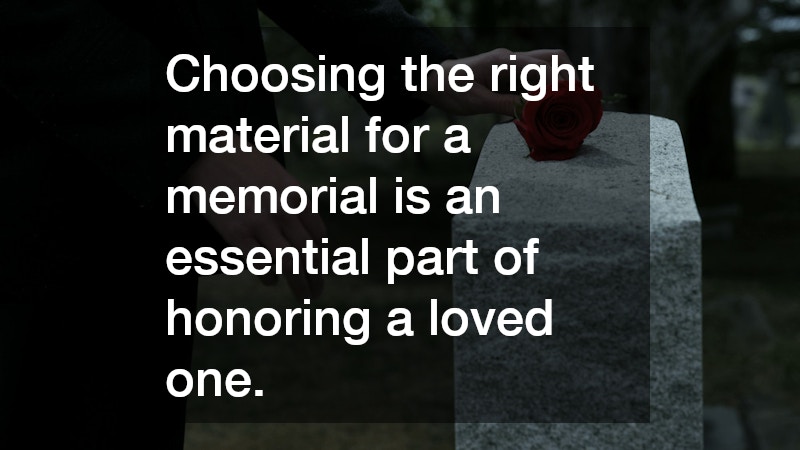Top Materials Used in Custom Headstones and Their Benefits
Selecting a headstone for a loved one is an important decision that reflects both memory and legacy. Beyond the design and inscription, the material chosen plays a significant role in the durability, appearance, and maintenance of the memorial. Understanding the most common materials used in custom headstones can help families make an informed choice that will stand the test of time while honoring their loved one’s memory. Each material has unique qualities that influence aesthetics, longevity, and cost.
Granite
Granite is the most widely used material for custom headstones, and for good reason. Its natural strength and resistance to weathering make it ideal for outdoor monuments that must endure harsh conditions for decades. Available in a variety of colors—from classic black and gray to vibrant reds and blues—granite offers a wide range of design possibilities.
One of granite’s main benefits is its ability to be polished to a high shine or left with a more natural, textured finish. This flexibility allows families to choose a style that complements the cemetery environment and personal taste. Inscriptions and detailed carvings, including portraits or symbols, can be etched deeply into the stone, ensuring legibility for generations. Granite is also relatively low-maintenance; periodic cleaning is usually enough to keep it looking pristine.
Because of its durability and versatility, granite remains the preferred choice for families seeking a long-lasting, elegant memorial.
Marble
Marble has been a traditional material for memorials for centuries, known for its smooth texture and timeless beauty. Its soft, elegant appearance lends itself well to intricate carvings and artistic detailing, making it ideal for headstones with elaborate designs or figurative engravings.
However, marble is softer than granite, which makes it more susceptible to weathering and erosion over time. Acid rain, wind, and other environmental factors can gradually wear away inscriptions and surface details. For this reason, marble is often chosen for indoor memorials, mausoleums, or cemetery locations with less exposure to harsh weather.
The main benefit of marble lies in its aesthetic appeal. Its unique veining and natural color variations create a one-of-a-kind look for every memorial. Families who value artistry and classical elegance often select marble, understanding that it requires more care to maintain its appearance over time.
Bronze
Bronze offers a distinct alternative to stone, combining durability with a sophisticated metallic appearance. Bronze headstones often feature a metal plaque mounted on a granite base, or the entire memorial may be cast in bronze. This material is highly resistant to corrosion and can endure extreme weather without losing detail, making it suitable for long-term outdoor placement.
Bronze allows for fine detail in lettering, relief images, and other decorative elements. Its warm, rich color develops a natural patina over time, adding character and depth to the memorial. Unlike stone, bronze is less prone to chipping or cracking, and it can withstand significant impact or shifting ground conditions.
For families seeking a memorial with a combination of durability and artistic expression, bronze provides a lasting tribute that is both elegant and low-maintenance. Additionally, bronze headstones offer the advantage of customization through detailed engravings and relief work, allowing families to incorporate personal symbols, portraits, or meaningful inscriptions. Over time, the natural patina that develops on bronze adds character and depth, creating a unique appearance that evolves gracefully with age.
Other Materials
While granite, marble, and bronze dominate the market, other materials are sometimes used for custom headstones depending on specific needs or preferences. Limestone and sandstone offer softer, more traditional aesthetics, but they weather more quickly and are best suited for sheltered environments or indoor memorials. Slate provides a smooth, refined surface and is relatively easy to engrave, though it can be brittle in extreme conditions.
Some families may also explore modern composites or environmentally friendly options, which can replicate the appearance of traditional materials while offering lightweight or sustainable alternatives. These materials often require less maintenance but may not have the same longevity as granite or bronze.
Considering the cemetery location, climate, and desired longevity is crucial when evaluating alternative materials for a headstone. It’s also important to weigh factors such as maintenance requirements, cost, and aesthetic preferences when selecting a material. Some softer stones may require more frequent care to prevent erosion or damage, while others may be more resistant to weathering but offer fewer design options.
Choosing the right material for a memorial is an essential part of honoring a loved one. Granite, marble, and bronze each offer unique benefits, balancing durability, aesthetics, and maintenance needs. Granite provides long-lasting strength and versatility, marble delivers timeless elegance and artistry, and bronze combines resilience with intricate design potential. Other materials like limestone, sandstone, or modern composites offer additional options for families with specific preferences.
Understanding the characteristics and advantages of each material ensures that your custom headstones not only reflect the personality and memory of your loved one but also remain a lasting tribute for generations to come. By making an informed choice, families can create a memorial that is both beautiful and enduring, celebrating a life with dignity and care.






